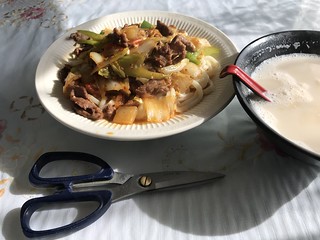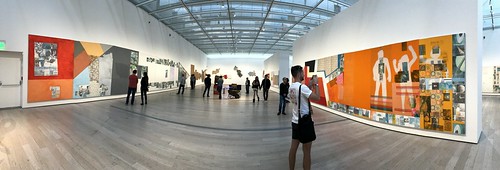Xinjiang, which literally means “new frontier”, is an autonomous province in the far northwest of China, along the Silk Road, the center of waves of cross-cultural pollination from Persia, Mongolia, Turkic tribes, and the neighboring ‘Stans. One of the main ethnic groups there are the Uyghurs, an Islamic people. This being LA, its own cultural cross-roads, of course there’s a restaurant for Halal Uyghur food. And of course I heard about it on KCRW's Good Food show. So I went to check it out. Delicious! I went for the “lag man”, thick hand-rolled noodles served in a hot broth with celery, peppers, and slices of lamb redolent with cumin and chili (modest heat but not tongue-scorching). The noodles are soft and chewy, thick enough that the bowl comes with shears to tame them. For traditional beverage, I took the milk tea, which comes served in a bowl with ladle-like spoon. It was like a really good chai, but with a distinctive hit of salt. A unique blend of broth and tea. For dessert, there’s a house made yogurt which was lovely, naturally sweet from the milk and without a strong fermentation tartness. I want to come back and try more! As an added bonus, while I was eating, who else came in but Evan Kleiman with her KCRW show team including Nick Liao and Abbie Fentress Swanson who produced the Uyghur segment. I was a bit starstruck, but said a quick hello and thanks - so cool to meet them!
Thursday, December 27, 2018
Sunday, December 16, 2018
ART: Rauschenberg's 1/4 Mile
A visiting friend provided a great excuse to check out Robert Rauschenberg's "The 1/4 Mile or 2 Furlongs" at LACMA. Rauschenberg was a renowned late 20th century American artist whose work was exemplified by assemblage of photographs, printed matter, and found objects, combined with overpainting. "The 1/4 Mile or 2 Furlongs" is a single work comprising 190 panels, plus some sculptural objects and some audio tracks, which if laid out linearly would actually be almost 1/4 mile long. The work grew over the course of 17 years (1981-1998) and is kind of a self-contained retrospective of the artist's career, with references to many of his other major works and showing an evolution of styles and phases, a creative array of visual stimulation running the gamut from murky to boldly colorful, and from purely abstract geometrics to human and natural forms. It was intriguing to contemplate the variety of colors and forms in the various panels and other bits and pieces, and also intriguing to think of it as one huge work rather than 200 individual works, and just how that makes you view it differently. I found myself thinking more about order, relationship, and juxtaposition as we wandered through it.
Subscribe to:
Posts (Atom)


